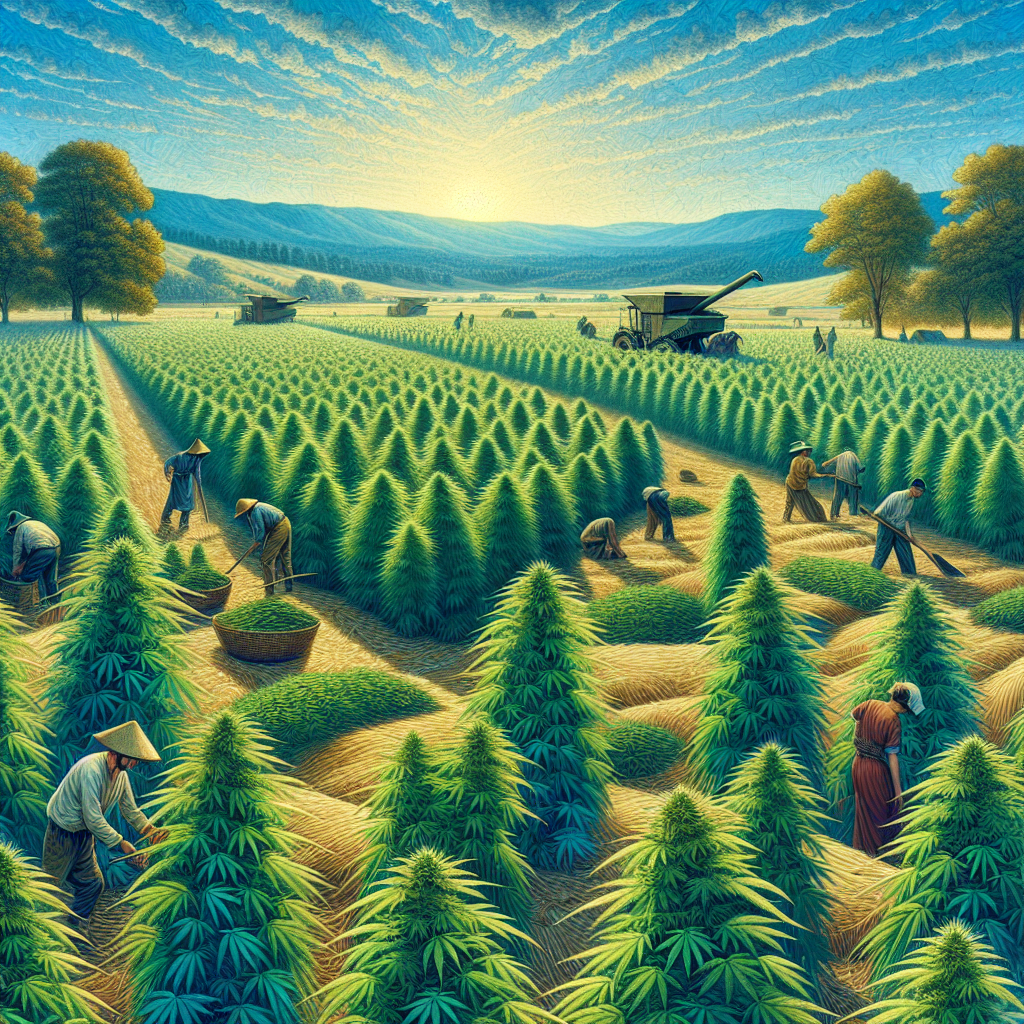Welcome to our comprehensive guide on how hemp paper is made. Hemp, a versatile and sustainable plant, has been used for centuries to create a variety of products, including paper. With the growing interest in eco-friendly and sustainable alternatives, hemp paper is experiencing a resurgence in popularity.
In this article, we will delve into the fascinating process of turning hemp into paper. From the initial stages of harvesting hemp to the final product, we will explore each step in detail. By understanding this process, you’ll gain a deeper appreciation for the benefits and potential of hemp paper.
At Smoke Show Labs, we are passionate about innovation and sustainability. Our expertise in Delta-8 (hemp) vape manufacturing, co-packing, and white labeling extends beyond vapes to other hemp-based products. If you’re thinking about starting your own Delta-8 brand, let’s start your Delta-8 brand with us.
Now, let’s dive into the first step of the hemp paper-making process: harvesting the hemp plants.
Harvesting and Preparing Hemp
The journey of making hemp paper begins with the crucial step of harvesting the hemp plants. Hemp is typically grown in well-drained soil with a good amount of sunlight. The plants are ready for harvest within 3 to 4 months, depending on the variety and growing conditions. When the stalks reach maturity, they are cut down and left to dry in the fields.
Drying the hemp stalks is an essential process that helps reduce moisture content and prepares the fibers for the next stages. Once dried, the stalks undergo a process known as retting. Retting can be done through various methods such as water retting, dew retting, or mechanical retting. This process helps to break down the pectins that bind the fibers together, making it easier to separate them.
After retting, the hemp stalks are broken down further through a process known as decortication. This involves crushing the stalks to separate the long bast fibers from the woody core or hurd. The bast fibers are primarily used for making paper, while the hurd can be used for other applications such as animal bedding or building materials.
With the bast fibers separated and prepared, they are now ready to be processed into pulp, which is the next critical step in the hemp paper-making process.
Hemp Fiber Separation Process

After harvesting and preparing the hemp, the next pivotal stage is the hemp fiber separation process. This step is crucial for producing high-quality hemp paper as it ensures that the fibers are clean and well-prepared for pulping.
The process begins with the decortication stage, where the dried and retted hemp stalks are mechanically crushed and separated. This mechanical action splits the stalks into their two main components: the long bast fibers and the woody core, also known as the hurd. The bast fibers are the valuable part used in papermaking due to their strength and flexibility.
Once the bast fibers are separated, they undergo further cleaning to remove any remaining hurd particles, dust, and impurities. This is often done using a series of mechanical combing or carding processes, which align the fibers and ensure they are free from contaminants.
In some cases, the fibers may also be subjected to chemical treatment to remove lignin and other non-cellulosic materials. This step is essential for producing a pulp that is suitable for making high-quality paper. The chemical treatment typically involves soaking the fibers in a solution of water and mild chemicals, which helps to break down and dissolve the unwanted components.
After thorough cleaning and treatment, the fibers are then rinsed and dried, making them ready for the subsequent pulping process. The meticulous attention to detail during the hemp fiber separation process ensures that the resulting pulp is of the highest quality, leading to superior hemp paper.
Pulping and Refining Hemp Fibers

Once the hemp fibers have been meticulously separated and cleaned, the next critical step in the journey of how hemp paper is made is the pulping and refining process. This stage transforms the raw hemp fibers into a malleable pulp, which is essential for paper production.
The pulping process begins by breaking down the cleaned hemp fibers into a fibrous mass. This can be achieved through a variety of methods, including mechanical, chemical, or a combination of both. In mechanical pulping, the fibers are mechanically ground down, while chemical pulping involves using chemicals to dissolve the lignin that binds the fibers together. A common method used in hemp pulping is the soda pulping process, which employs sodium hydroxide to break down the fibers.
During this phase, the goal is to achieve a fine balance between fiber length and flexibility. Shorter fibers can lead to weaker paper, while excessively long fibers can result in a rough texture. The refined pulp is then washed to remove any residual chemicals and impurities, ensuring it is clean and uniform in consistency.
Next, the pulp undergoes a refining process, which involves passing the fibrous mass through a series of refining machines. This step is crucial as it further breaks down the fibers, enhancing their bonding capabilities. The refining process also plays a significant role in determining the final texture and strength of the paper. The better the fibers are refined, the smoother and stronger the paper will be.
After refining, the pulp is ready for the papermaking process. It is typically diluted with water to create a slurry, which facilitates the formation of paper sheets in the subsequent steps. The meticulous pulping and refining of hemp fibers ensure that the final product is of premium quality, making hemp paper a sustainable and durable alternative to traditional paper.
Forming and Drying Hemp Paper

With the hemp pulp now refined and prepared, the process of how hemp paper is made progresses to the forming and drying stages. These steps are where the slurry of hemp fibers begins its transformation into actual paper sheets.
The forming process starts by pouring the diluted hemp pulp onto a wire mesh or screen, which allows the water to drain away while leaving behind an even layer of fibers. This screen is part of a larger machine known as a Fourdrinier machine, commonly used in the paper-making industry. As the water drains, the fibers start to bond together, forming a wet mat of interlaced hemp fibers.
Once the initial layer is formed, it passes through a series of rollers that press the fibers together, further expelling water and compacting the fibers into a more cohesive sheet. This stage is critical for achieving the desired thickness and uniformity in the paper. The pressure applied by the rollers also helps to enhance the bonding between the fibers, contributing to the overall strength of the final product.
After pressing, the still-wet hemp paper needs to be dried. This is typically done using heated drying cylinders or air dryers, which quickly evaporate the remaining moisture. The drying process not only reduces the water content but also helps to set the fibers in place, giving the paper its final structure and texture. During drying, care must be taken to ensure that the paper does not warp or shrink, which could affect its quality.
As the paper dries, it is continuously monitored and adjusted to ensure consistency and quality. The result is a sheet of hemp paper that is not only environmentally friendly but also incredibly durable and versatile. From this point, the paper can be further processed, cut, and packaged for various applications, ranging from stationery to packaging materials.
Finishing and Uses of Hemp Paper

The final steps in understanding how hemp paper is made involve finishing and identifying its potential uses. After the forming and drying stages, the hemp paper undergoes various finishing processes to enhance its quality and functionality. These processes include smoothing, coating, and cutting.
Smoothing is achieved by passing the dried hemp paper through a series of calender rollers, which compress and polish the surface, making it more uniform and suitable for printing. Coating may involve applying a thin layer of materials like clay or latex to improve the paper’s brightness, smoothness, and ink receptivity. This step is particularly important for applications that require high-quality prints or intense colors.
The paper is then cut into the desired sizes and shapes, depending on its intended use. This cutting process can range from large industrial rolls to smaller sheets for stationery or printing purposes. Each piece of hemp paper is inspected for defects and inconsistencies to ensure that only the best quality reaches the market.
Hemp paper’s versatility is one of its most significant advantages. It is used in a wide array of products, from everyday items like notebooks and printer paper to more specialized applications such as archival documents, banknotes, and even eco-friendly packaging. The durability and sustainability of hemp paper make it an excellent alternative to traditional wood-based paper, which is often less environmentally friendly.
With the growing interest in sustainable materials, hemp paper is finding its place in various industries looking to reduce their environmental footprint. Whether you’re a consumer seeking eco-friendly products or a business aiming to adopt sustainable practices, hemp paper offers a viable solution.
Let’s start your Delta-8 brand and explore the endless possibilities of hemp-based products. Visit Smoke Show Labs to learn more!

